Click on images to enlarge
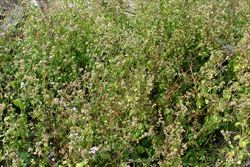
dense infestation (Photo: Sheldon Navie)
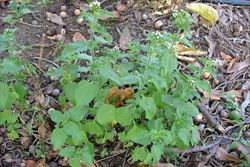
habit (Photo: Sheldon Navie)
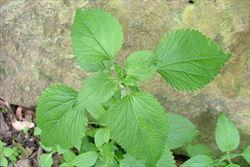
leaves (Photo: Sheldon Navie)
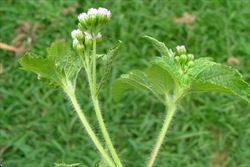
hairy stems and young flower-heads (Photo: Sheldon Navie)

cluster of flower-heads at the top of the stem (Photo: Sheldon Navie)
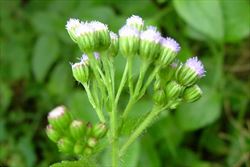
close-up of flower-heads showing their sparsely hairy bracts (Photo: Sheldon Navie)
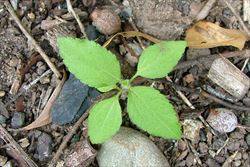
seedling (Photo: Sheldon Navie)

comparison of billygoat weed (Ageratum conyzoides), with sparsely hairy bracts and short floral projections on the left, and blue billygoat weed (Ageratum houstonianum), with very hairy bracts and long floral projections on the right (Photo: Sheldon Navie)
Scientific Name
Ageratum conyzoides L.
Synonyms
Ageratum conyzoides L. subsp. conyzoides
Family
Asteraceae (Queensland, New South Wales, the ACT, Victoria, Tasmania, Western Australia and the Northern Territory)Compositae (South Australia)
Common Names
ageratum, billy goat weed, billy-goat weed, billygoat weed, billygoat-weed, blue top, blue top weed, bluetop, chick weed, floss flower, flossflower, goat weed, goatweed, invading ageratum, tropic ageratum, tropical whiteweed, white weed, whiteweed, winter weed
Origin
This species probably originated in Central and South America, but its exact native enrage is obscure. It is now very widespread in tropical and sub-tropical regions of the world.
Naturalised Distribution
Widely naturalised in the wetter parts of northern Australia. It is common and widespread throughout the coastal districts of eastern Queensland, from Cape York to the New South Wales border. It is relatively common in the north-western parts of the Northern Territory and in the coastal districts of northern New South Wales, north from the Maclean district. Also occasionally recorded in the Kimberley region in northern Western Australia and in other parts of Queensland. Also naturalised on Lord Howe Island, Norfolk Island and Christmas Island.
Notes
Billygoat weed (Ageratum conyzoides) is regarded as an environmental weed in eastern Queensland. This species is a common weed of disturbed sites, waste areas, roadsides, gardens, pastures and crops (particularly plantation crops such as sugar cane) in warmer areas. It is mainly regarded as a pest of agriculture and habitation, but it also invades natural areas.
In northern Queensland it is a weed of rainforests and associated ecosystems, and is found in forests gaps and disturbed areas. For example, it is a common weed of powerline corridors in the Wet Tropics World Heritage Area and is also known to invade revegetation sites in this region. Billygoat weed (Ageratum conyzoides) is listed as a low priority pest plant of regional significance in the Mackay-Whitsunday region in central Queensland and has been recorded in conservation areas near Mackay (i.e. Mount Jukes National Park and Mount Blackwood National Park). This species is also a common weed of riparian areas in south-eastern Queensland and has also been recorded in conservation areas in this region (e.g. in Brisbane Forest Park).
In the Northern Territory, billygoat weed (Ageratum conyzoides) is currently found in the East Alligator River and Finnis River catchments. It is also a minor weed in aboriginal lands in the Northern Land Council area, which is considered to pose a low level of threat to natural areas.
In Fiji, this species is abundantly naturalised in clearings, cultivated areas, grasslands and forests (often along trails and roads). During a recent study, billygoat weed (Ageratum conyzoides) was found to be one of the most common invasive plant species in Himachal Pradesh province in north-western India, and was one of three species that has displaced native flora and reduced their abundance to such an extent that they were threatening the integrity of native ecosystems. In sites invaded by billygoat weed (Ageratum conyzoides), the species diversity of was reduced by 30%. This weed is also thought to be among the most invasive species in southern Africa, and is regarded as a threat to the biodiversity of this region. Here it is noted to invade riverbeds, riverbanks, forest margins, plantations, grassland, wetlands, and croplands and often forms dense stands that exclude other species.

